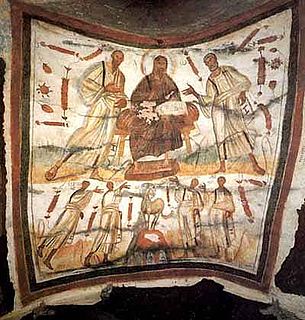 W
WThe Decapolis was a group of ten cities on the eastern frontier of the Roman Empire in the southeastern Levant in the first centuries BC and AD. They formed a group because of their language, culture, location, and political status, with each functioning as an autonomous city-state dependent on Rome. They are sometimes described as a league of cities, although some scholars believe that they were never formally organized as a political unit.
 W
WThe Flavian dynasty ruled the Roman Empire between AD 69 and 96, encompassing the reigns of Vespasian (69–79), and his two sons Titus (79–81) and Domitian (81–96). The Flavians rose to power during the civil war of 69, known as the Year of the Four Emperors. After Galba and Otho died in quick succession, Vitellius became emperor in mid 69. His claim to the throne was quickly challenged by legions stationed in the Eastern provinces, who declared their commander Vespasian emperor in his place. The Second Battle of Bedriacum tilted the balance decisively in favour of the Flavian forces, who entered Rome on December 20. The following day, the Roman Senate officially declared Vespasian emperor of the Roman Empire, thus commencing the Flavian dynasty. Although the dynasty proved to be short-lived, several significant historic, economic and military events took place during their reign.
 W
WMost scholars who study the historical Jesus and early Christianity believe that the canonical gospels and the life of Jesus must be viewed within their historical and cultural context, rather than purely in terms of Christian orthodoxy. They look at Second Temple Judaism, the tensions, trends, and changes in the region under the influence of Hellenism and the Roman occupation, and the Jewish factions of the time, seeing Jesus as a Jew in this environment; and the written New Testament as arising from a period of oral gospel traditions after his death.
 W
WThe Julio-Claudian dynasty comprised the first five Roman emperors: Augustus, Tiberius, Caligula, Claudius, and Nero. They ruled the Roman Empire from its formation under Augustus in 27 BC until AD 68, when the last of the line, Nero, committed suicide. The name "Julio-Claudian" is a historiographical term derived from the two families which composed the imperial dynasty: the Julii Caesares and Claudii Nerones.
 W
WThe Nemi ships were two ships, one larger than the other, built under the reign of the Roman emperor Caligula in the 1st century AD at Lake Nemi. Although the purpose of the ships is only speculated upon, the larger ship was essentially an elaborate floating palace, which contained quantities of marble, mosaic floors, heating and plumbing and amenities such as baths. Both ships featured technology thought to have been developed historically much later. It has been stated that the emperor was influenced by the lavish lifestyles of the Hellenistic rulers of Syracuse and Ptolemaic Egypt. Recovered from the lake bed in 1929, the ships were destroyed by fire during World War II in 1944.
 W
WThe Pax Romana is a roughly 200-year-long period in Roman history which is identified with increased and sustained inner hegemonial peace and stability. It is traditionally dated as commencing from the accession of Caesar Augustus, founder of the Roman principate, in 27 BC and concluding in 180 AD with the death of Marcus Aurelius, the last of the "Five Good Emperors". Since it was inaugurated by Augustus with the end of the Final War of the Roman Republic, it is sometimes called the Pax Augusta. During this period of approximately two centuries, the Roman Empire achieved its greatest territorial extent and its population reached a maximum of up to 70 million people. According to Cassius Dio, the dictatorial reign of Commodus, later followed by the Year of the Five Emperors and the crisis of the third century, marked the descent "from a kingdom of gold to one of iron and rust".
 W
WThe Roman conquest of Britain was a gradual process, beginning in AD 43 under Emperor Claudius and being largely completed by 87 when the Stanegate was established as the northern frontier.
 W
WThe Pilate stone is a damaged block of carved limestone with a partially intact inscription attributed to, and mentioning, Pontius Pilate, a prefect of the Roman province of Judaea from AD 26 to 36. It was discovered at the archaeological site of Caesarea Maritima in 1961. The artifact is particularly significant because it is an archaeological find of an authentic 1st-century Roman inscription mentioning the name "[Pont]ius Pilatus". It is contemporary to Pilate's lifetime, and accords with what is known of his reported career. In effect, the inscription constitutes the earliest surviving, and only contemporary, record of Pilate, who is otherwise known from the New Testament, the Jewish historian Josephus and writer Philo, and brief references by Roman historians such as Tacitus.